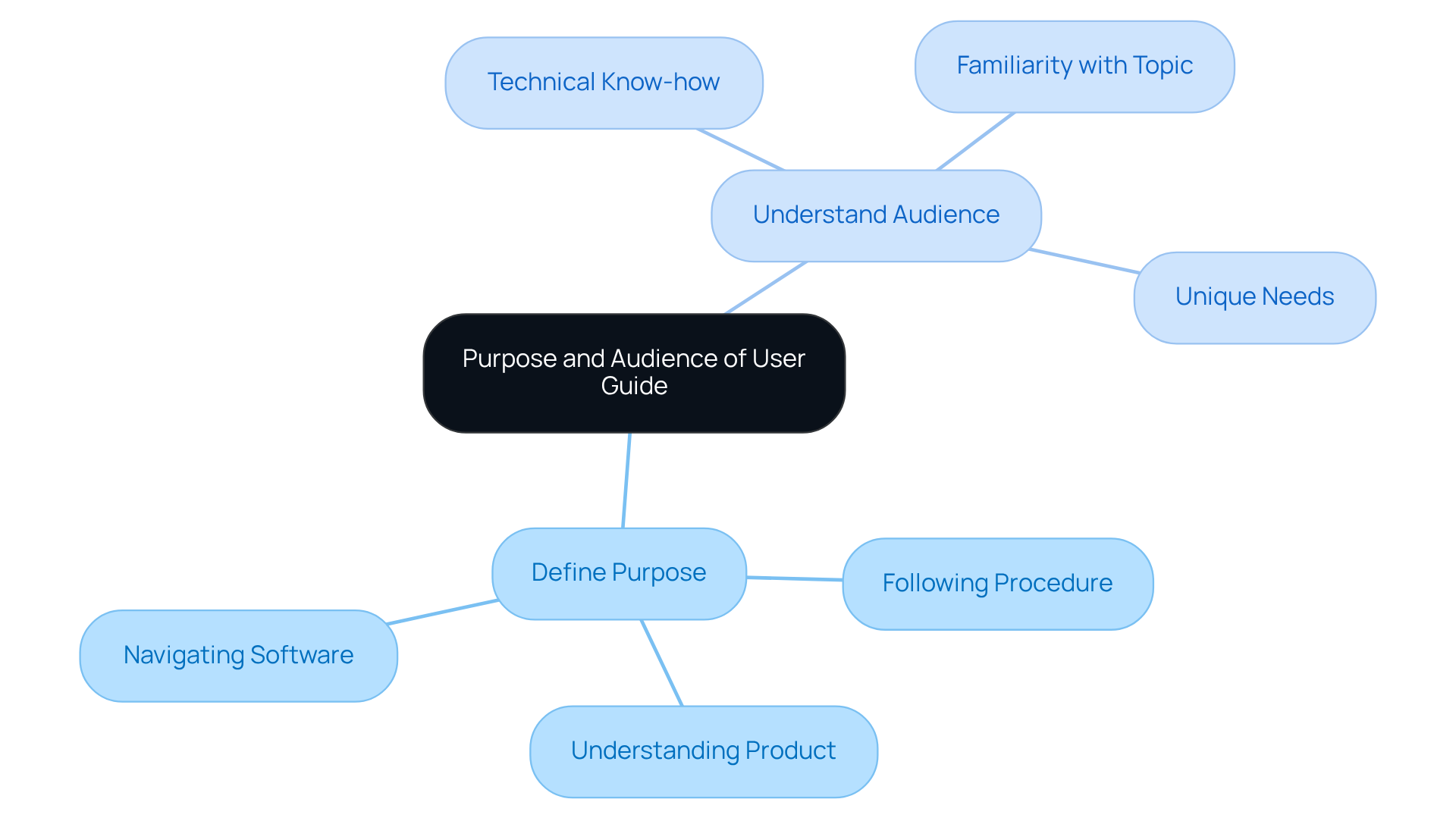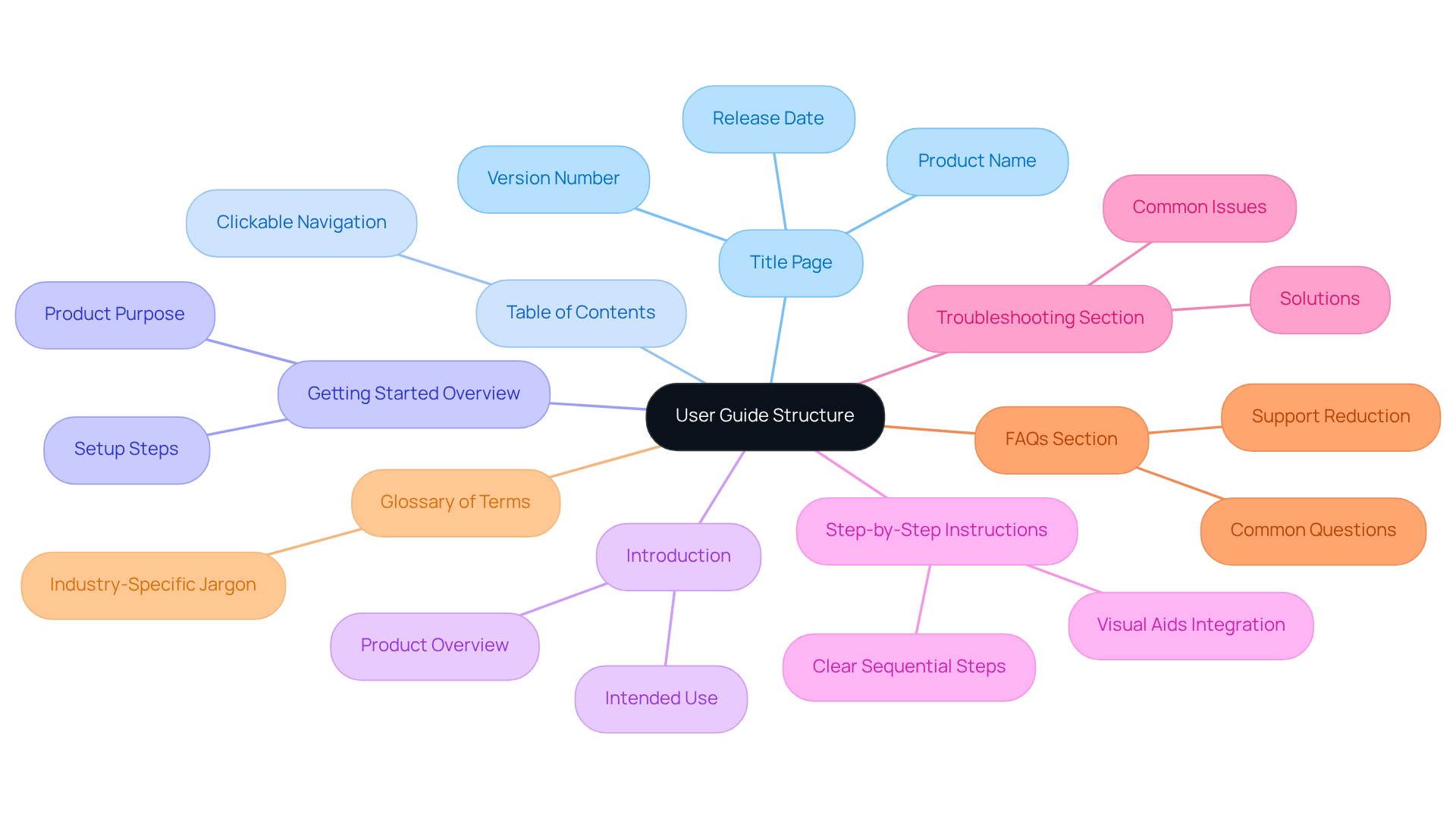
Process Improvement through Documentation
|
November 6, 2025
|
Master Creating a User Guide in Word: 4 Essential Steps
Overview
Creating an effective user guide in Microsoft Word? You might be wondering where to start! Well, there are four essential steps to keep in mind.
-
First off, it’s all about defining the manual's purpose and audience. Who are you writing for? Understanding this helps you tailor your content to meet their needs.
-
Next, let’s outline the structure. A well-organized guide makes it easier for users to find what they need. Think about how you can break down the information into clear sections.
-
Now, don’t forget to utilize all those handy Word features! They can really enhance your document and make it more engaging.
-
Finally, conducting thorough reviews is key. This step ensures clarity and usability. You want to make sure your guide is user-friendly and meets their expectations.
Remember, clarity and audience engagement are crucial! By following these steps, you’ll create a user guide that not only informs but also enhances satisfaction through effective communication. So, are you ready to dive in and start crafting your guide?
Key Highlights:
- Define the purpose of the manual to address specific user needs, such as navigating software or understanding products.
- Identify the target audience's technical knowledge and familiarity with the topic to tailor language and explanations.
- A well-crafted manual enhances user satisfaction and engagement through clear communication.
- Outline essential sections of the user guide, including Getting Started, Introduction, Step-by-Step Instructions, Troubleshooting, FAQs, and Glossary.
- Utilise Microsoft Word features like styles, tables, images, and a clickable table of contents to enhance clarity and navigation.
- Conduct thorough reviews and usability testing to ensure clarity, accuracy, and relevance of the manual.
- Involve colleagues for feedback during the review process to catch errors and improve clarity.
Introduction
Creating a user guide isn’t just about throwing together some instructions; it’s about crafting a resource that really connects with your audience. You might be wondering, how do you make sure your guide hits the mark? By clearly defining its purpose and understanding who’s going to use it, you can boost user satisfaction and engagement. But let’s face it, how can you ensure your documentation stands out in a sea of generic manuals?
This article dives into four essential steps for mastering the art of user guide creation in Microsoft Word. We’re here to offer insights that promise to turn those bland instructions into a user-friendly experience. So, let’s get started!
Define the Purpose and Audience of Your User Guide
Creating an effective manual? It all starts with nailing down its purpose. Think about the specific issue your manual is addressing: Is it meant to help folks navigate a software application, understand a product, or follow a procedure? Once you’ve got that purpose clear, the next step is to figure out who your audience is. Consider their technical know-how, how familiar they are with the topic, and what unique needs they might have. For example, if you’re crafting a resource for beginners, you’ll want to use simpler language and provide more detailed explanations compared to one aimed at advanced users. Documenting these insights is key, as they’ll guide your writing style and content structure as you develop your manual.
Understanding your audience's needs is super important in resource development. Experts in the field often highlight that a well-crafted manual not only boosts satisfaction but also encourages engagement. When your communication is clear, it directly impacts how effectively people can use the resource. So, prioritizing audience analysis in your writing strategy? Absolutely crucial!
You might be wondering how to keep your readers engaged. Well, think about it: a manual that speaks directly to its audience can make all the difference. So, let’s dive into how you can make your documentation not just informative, but also a joy to read!

Outline the Structure and Key Components of the User Guide
Defining your purpose and audience is just the beginning! Outlining the structure of your manual is key when creating a user guide in Word to make it effective. With this platform, you can whip up guides in no time, especially creating a user guide in Word, keeping your documentation fresh and relevant in today’s fast-paced business world. So, let’s kick things off with a title page that showcases the product name, version number, and release date. After that, a clickable table of contents will make navigation a breeze.
Now, what should you include? Here are some essential sections:
- Getting Started Overview: This is where you explain what the product is all about and the setup steps needed. It gives users the context they need. The platform makes the process of creating a user guide in Word super easy by allowing you to create this section quickly based on user input.
- Introduction: Here, you’ll provide an overview of the product and its intended use. You can maintain consistency when creating a user guide in Word by using available templates.
- Step-by-Step Instructions: Break down tasks into clear, sequential steps. Numbered lists and screenshots work wonders for clarity. Plus, this platform allows you to easily integrate visual aids while creating a user guide in Word, including annotated visuals and videos.
- Troubleshooting Section: Address common issues users might face, along with solutions. Organize this under logical headings for convenience. The platform can even help with creating a user guide in Word by automating this content based on user feedback.
- FAQs Section: Include commonly asked questions to clear up any confusion and reduce support inquiries. Analytics can help you pinpoint those typical queries.
- Glossary of Terms: Define any industry-specific jargon to help first-time visitors. You can easily compile this by creating a user guide in Word with the documentation features available.
Make sure each section has clear headings and subheadings to guide your readers effectively. For instance, in a software manual, you might want sections on installation, basic functions, and advanced features. And if your product deals with sensitive data, don’t forget to add legal or compliance notes to boost credibility.
This structured approach not only enhances the client experience but also ensures that information is easy to find, leading to greater satisfaction and fewer support inquiries. With a streamlined solution for records, you can simplify process standardization, onboarding, and knowledge sharing, which can really boost team efficiency. So, are you ready to dive in and make your documentation shine?

Utilize Microsoft Word Features to Design Your User Guide
You might be wondering how to make your manual really pop when creating a user guide in Word. Well, it’s all about creating a user guide in Word that utilizes the right features! Start by creating a user guide in Word that includes styles for your headings and subheadings. This process of creating a user guide in Word keeps everything consistent and easy to follow. And don’t forget about bullet points and numbered lists—they’re your best friends when creating a user guide in Word to ensure clarity in instructions.
Now, let’s discuss creating a user guide in Word. In creating a user guide in Word, incorporating tables and images can really help illustrate those complex concepts you’re trying to explain. Plus, creating a user guide in Word that utilizes the 'Insert Table of Contents' feature makes navigation a breeze for your readers. Remember to sprinkle in some page breaks to separate sections when creating a user guide in Word; it keeps your layout looking clean and organized.
For an even smoother process, consider using an instant record solution. This nifty tool lets you create manuals effortlessly and keeps them updated in real-time. Imagine how much easier that makes sharing knowledge and boosting team efficiency! So, why not give it a shot? You’ll be amazed at how effective your documentation can be!

Review and Edit Your User Guide for Clarity and Accuracy
Once you’ve got your user manual drafted, you might be wondering about creating a user guide in Word as the next step. Well, it’s time for a thorough review to make sure everything is clear and precise! With SowFlow's instant documentation solution, you can easily tap into documentation expertise with just one command. This way, your manual stays relevant in our fast-paced business world.
Start by checking for any grammatical errors, unclear instructions, or formatting inconsistencies. It can be super helpful to involve a colleague in this process—they might catch mistakes you’ve missed and offer some great feedback on how clear the document is. Speaking of clarity, have you thought about usability testing? Testing your manual with a sample of your target audience is crucial. It ensures that your manual meets their needs and is easy to understand.
Research shows that usability testing can really boost the effectiveness of instructional materials, leading to happier users and less confusion. After you gather feedback, don’t forget to make those necessary revisions! This will help elevate the overall quality of creating a user guide in Word, ensuring it does its job effectively.

Conclusion
Creating a user guide in Microsoft Word can be a breeze if you take a systematic approach that focuses on clarity, structure, and keeping your audience engaged. You might be wondering how to start? Well, defining the purpose and audience right from the get-go is key. This way, your content will really resonate with users, making their experience and understanding of the material so much better.
Throughout this guide, we’ve highlighted some essential steps. We’re talking about outlining the structure and components of your user guide and making the most of Microsoft Word’s features. Key elements like:
- A clickable table of contents
- Step-by-step instructions
- A troubleshooting section
are super important for helping users navigate and comprehend the information. And don’t forget—reviewing and editing for clarity and accuracy is crucial. A polished final product is what meets user needs!
Now, let’s wrap this up. Creating a user guide isn’t just about jotting down information; it’s about crafting a resource that truly empowers users and helps them interact with a product or service. By following these best practices and tapping into Microsoft Word’s capabilities, you can whip up a user guide that’s both informative and engaging. Remember, understanding your audience and refining your content will not only boost the quality of your documentation but also enhance user satisfaction. In the end, your guide can become an invaluable tool in any setting!
Frequently Asked Questions
What is the first step in creating an effective user guide?
The first step is to define the purpose of the manual, determining the specific issue it addresses, such as navigating a software application, understanding a product, or following a procedure.
How important is understanding the audience when developing a user guide?
Understanding the audience is crucial as it influences the writing style and content structure. Knowing their technical know-how and familiarity with the topic helps tailor the manual to meet their unique needs.
What should you consider when identifying your audience?
Consider the audience's technical knowledge, familiarity with the topic, and any specific needs they might have. For instance, a manual for beginners should use simpler language and provide more detailed explanations than one aimed at advanced users.
How does a well-crafted manual impact user satisfaction and engagement?
A well-crafted manual enhances user satisfaction and encourages engagement by providing clear communication, which directly affects how effectively users can utilize the resource.
What is the significance of documenting insights about the audience?
Documenting insights about the audience is key as it guides the writing style and content structure during the development of the manual, ensuring it resonates with the intended readers.
What can make a user guide more engaging for readers?
A user guide that speaks directly to its audience, using appropriate language and addressing their specific needs, can make the documentation more engaging and enjoyable to read.
👍
What others are liking
5 Steps to outline your ideal documentation structure
5 MINS READ
Where to start the your journey of mapping out your ideal documentation structure, aligning it with the very heartbeat of your organization?
Defining a winning level of detail in your process
3 MINS READ
What is too much detail, and what is too little? This article described in that winning level detail about what detail is enough.





